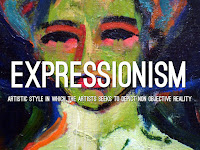Unit - 2 Trends and Movements (Th)
4)Dada Movement - (Add your class activity works - Painting, Poem, Photo )
Expressionism was a literary and artistic reaction against realism and naturalism. Writers were interested in emotion and psychology.
The Scream by Edvard Munch (1910): This iconic painting uses bold lines, expressive brushstrokes, and a distorted figure to convey feelings of anxiety, despair, and existential angst.
Modernism and Postmodernism :
I. Modernism (Late 19th Century - Mid 20th Century)
A. Key Characteristics:
Experimentation with Form:
Optimism and Progress:
B. Examples:
Visual Arts:
Architecture:
Modernism: "Guernica" by Pablo Picasso (1937): A powerful anti-war painting depicting the bombing of Guernica during the Spanish Civil War. Its fragmented forms and use of black, white, and grey exemplify the modernist emphasis on experimentation and the expression of complex emotions.
Guernica by Pablo Picasso
"Fallingwater" by Frank Lloyd Wright (1939): This house exemplifies the modernist ideal of integrating architecture with nature. Its cantilevered design and use of natural materials reflect the emphasis on functionality and simplicity.
Fallingwater house by Frank Lloyd Wright
"The Great Gatsby" book cover (1925):
Great Gatsby book cover
II. Postmodernism (Mid 20th Century - Present)
Postmodernism is a late 20th-century movement in philosophy and literary theory that generally questions the basic assumptions of Western philosophy in the modern period (roughly, the 17th century through the 19th century).
Skepticism and Irony:
Intertextuality and Pastiche:
Self-Reflexivity and Metafiction:
B. Examples:Literature:
Visual Arts:
Campbell's Soup Cans by Andy Warhol
Guggenheim Museum Bilbao by Frank Gehry (1997): This deconstructivism building features a dynamic, curvilinear design that breaks away from traditional architectural styles. It embodies the postmodernist emphasis on challenging established norms and embracing individual expression.
Guggenheim Museum Bilbao
"Midnight's Children" by Salman Rushdie (1981): This novel's magical realist style, blending history and fantasy, exemplifies the postmodernist embrace of multiple perspectives and the questioning of traditional narratives.
Midnight's Children book cover
Modernism and postmodernism represent distinct yet interconnected artistic and intellectual movements. While modernism sought new forms and meaning through a break with tradition, postmodernism challenged the certainty of those new forms and emphasized the plurality of perspectives and interpretations. Both movements have significantly shaped and continue to influence various aspects of contemporary thought and cultural production.
Absurdism :
Absurdism explores how humans want meaning, but the world might not have any. We see this in art:
- Melting clocks: This painting shows how time might not matter, even though we want it to.
- Endless task: This artwork shows a man pushing a rock uphill, forever. It's like some tasks in life feel pointless.
Dadaism: Rebelling Against the Meaningless
Dadaism, an art movement born in the aftermath of World War I, aimed to challenge established norms and express the absurdity of a world that had produced such senseless destruction. Here's a simple explanation with an image:
- Think of it as a big "NO!" to war and tradition. Dada artists used nonsensical elements and playful techniques to make fun of seriousness and question what art even is.
For example, this artwork, called "Fountain," is actually a urinal signed by the artist. By presenting an ordinary object as art, Dada artists questioned the traditional definition of art and challenged the authority of the art world.
Citation :
Baldwin, Emma. "Expressionism". Poem Analysis, https://poemanalysis.com/movement/expressionism/. Accessed 1 March 2024.







Comments
Post a Comment